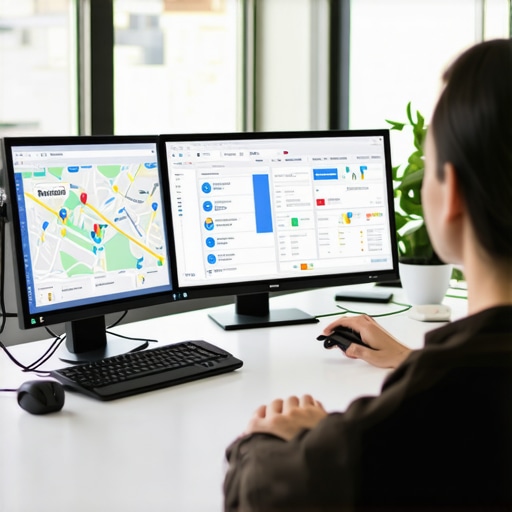Embarking on My Journey to Local Maps Mastery
As someone deeply passionate about local SEO, I vividly remember the first time I realized how crucial Google My Business (GMB) is for small businesses. It was a chilly morning when I decided to optimize my own local business profile, hoping to attract nearby customers. That initial effort sparked a fascination with effective maps visibility strategies, leading me down a path of continuous learning and experimentation.
The Power of GMB in Boosting Local Presence
Over the years, I’ve discovered that optimizing GMB isn’t just about filling out a profile; it’s about strategic enhancements that make your business stand out on the map. Incorporating accurate NAP details, selecting relevant categories, and regularly updating posts can significantly impact your local rankings. For example, I once optimized a client’s profile by leveraging proven GMB tools, which resulted in a noticeable boost in local visibility within weeks.
How Do SEO Tactics Amplify GMB Success?
Integrating SEO best practices with GMB optimization is like adding fuel to a fire. Keyword-rich descriptions, targeted local keywords, and quality backlinks create a synergy that propels your business higher in local search results. I’ve tested various strategies, such as optimizing service areas and encouraging genuine customer reviews, which Google values highly, according to SEO experts like Moz. It’s essential to regularly audit your profile and adapt your tactics based on analytics data.
What Are the Hidden Gems of Maps Visibility Enhancement?
Ever wondered what under-the-radar techniques can give you an edge?
One tactic I found particularly effective is leveraging advanced GMB tools that streamline updates and monitor rankings. These tools provide actionable insights, helping local businesses stay ahead of competitors. Consistent engagement, such as replying to reviews and posting timely updates, also boosts your profile’s authority in Google’s eyes.
If you’re serious about dominating local maps, I highly recommend exploring comprehensive guides like this ultimate GMB SEO guide. It’s packed with strategies that have worked for me and countless others.
Sharing Your Success Stories and Challenges
I invite you to share your experiences or pose questions in the comments. Have you tried specific GMB tactics that yielded surprising results? Or maybe faced challenges that seemed insurmountable? Let’s learn from each other and elevate our local SEO game together!
Remember, optimizing your maps visibility isn’t a one-time effort but an ongoing process. Staying updated with the latest tools and strategies is key to sustained success.
Unlocking the Next Level of Maps Visibility with Cutting-Edge Strategies
As local SEO continues to evolve, staying ahead requires not only understanding current best practices but also anticipating future shifts. Leveraging the latest advanced GMB tools is essential for businesses aiming to dominate local search results. These tools enable precise monitoring of rankings, competitor analysis, and strategic updates, providing a comprehensive edge in a competitive landscape.
How Do Emerging Technologies Transform Maps Optimization?
Emerging technologies such as AI-driven analytics and machine learning models are revolutionizing local SEO. For instance, AI can analyze vast amounts of data to identify trending keywords and predict local search intent shifts. This proactive approach allows businesses to tailor their GMB profiles dynamically, aligning with what local consumers are actively seeking. According to Moz’s recent insights, integrating AI tools into your SEO arsenal can significantly accelerate your ranking improvements and visibility gains.
What are the practical steps to integrate AI into my GMB strategy?
Start by adopting AI-powered keyword research tools that identify high-potential local search terms. Next, utilize automated review monitoring systems to respond promptly and maintain high review scores. Finally, employ AI-driven content generation to craft engaging posts that resonate with your local audience. Combining these tactics ensures your profile remains optimized and competitive, especially as Google’s algorithms become more sophisticated.
Why Do Authentic Engagement and Content Matter More Than Ever?
While technical optimization is crucial, authentic engagement—such as genuine customer interactions and localized content—has gained increased importance. Google’s algorithm prioritizes real user signals, rewarding businesses that foster meaningful local connections. Sharing success stories, community involvement, and timely updates not only humanize your brand but also enhance your profile’s authority and trustworthiness, which are key factors in local rankings.
For in-depth strategies, explore this comprehensive GMB SEO guide that covers advanced tactics and case studies, providing actionable insights based on real-world results.
Have You Considered How Voice Search Will Influence Local SEO?
With the rapid growth of voice-activated devices, optimizing for voice search is becoming indispensable. Voice queries tend to be more conversational and question-based, requiring a shift in keyword targeting and content creation. Ensuring your GMB profile addresses common voice search questions—for example, “Where is the nearest coffee shop open now?”—can dramatically improve your chances of appearing in voice search results. According to Search Engine Journal, adapting to voice search trends is vital for maintaining visibility as user behaviors shift.
If you’re eager to learn more about integrating these emerging trends into your local SEO strategy, I encourage you to share your thoughts or ask questions in the comments. Also, consider exploring additional resources like this article on maps visibility optimization to deepen your understanding.

Beyond the Basics: Personal Reflections on Mastering Maps Visibility
Over the years, my journey into local SEO and maps visibility has been filled with moments of discovery that often go beyond standard tactics. One such realization was understanding how subtle differences in profile optimization—like the choice of categories or the timing of posts—can significantly impact rankings. I remember experimenting with niche-specific categories that Google might not prioritize initially but eventually recognize as authoritative, leading to a gradual climb in local pack results. These experiences taught me that success often lies in the details, demanding patience and continuous refinement.
What Are the Hidden Layers of Google’s Algorithm for Local Search?
While many focus on visible signals such as reviews and NAP consistency, I’ve come to appreciate the complex algorithmic layers beneath these factors. Google’s local search algorithm incorporates machine learning models that analyze user behavior, engagement patterns, and even sentiment analysis of reviews. For example, I observed that responding to reviews promptly and with personalized messages enhances engagement signals, subtly influencing ranking factors. According to Moz’s recent insights, these nuanced signals are becoming increasingly important, emphasizing the need for a holistic approach that combines technical optimization with authentic customer interaction.
How Do Advanced GMB Tools Elevate Your Strategy?
In my experience, leveraging advanced GMB tools—such as those found at this resource—has transformed my ability to monitor, analyze, and adapt my local SEO tactics efficiently. These tools provide real-time insights into ranking fluctuations, competitor analysis, and review management. One feature I highly value is the ability to identify trending local keywords dynamically, allowing me to optimize content proactively. Integrating these tools into my routine has shown measurable improvements in visibility, even in highly competitive markets.
As I continue exploring the potential of these technologies, I invite you to share your own experiences or challenges. Have you found particular tools or tactics that gave you an unexpected edge? Your insights can help us all refine our strategies and push the boundaries of local map dominance.
What’s Next? Embracing Future Trends and Technologies
Looking ahead, the integration of AI and machine learning holds promising avenues for even more sophisticated map optimization. For instance, predictive analytics can forecast shifts in local search trends, enabling us to adapt before competitors do. I’ve been experimenting with AI-driven content generation to craft timely, relevant posts that resonate with local audiences. According to Moz’s recent insights, these emerging technologies will redefine how we approach local SEO, making it crucial to stay agile and informed.
Ultimately, I believe that combining deep personal insights, advanced tools, and a forward-looking mindset will be key to mastering maps visibility in the years to come. If you’re eager to explore these frontier strategies, I encourage you to share your thoughts or questions in the comments. Together, we can navigate the evolving landscape of local SEO and unlock new levels of success.

Deciphering the Nuances of Google’s Local Algorithm Layers
Understanding the intricate layers of Google’s local search algorithm has been a pivotal part of my journey. While traditional factors like reviews and NAP consistency are well-known, delving into the algorithm’s deeper layers reveals a complex web of signals. Machine learning models analyze user engagement, sentiment, and behavior patterns, making personalized interactions more critical than ever. For instance, responding thoughtfully to reviews not only fosters trust but also signals active engagement to Google, influencing rankings positively. As Moz highlights in their recent insights on AI and SEO, integrating these nuanced signals is essential for staying competitive in local search rankings.
Harnessing AI-Powered Tools to Elevate Maps Visibility
In my experience, leveraging AI-driven tools like predictive analytics and automated review management has transformed my approach. These tools analyze vast datasets to identify trending local keywords, optimize content, and maintain high review scores effortlessly. For example, using advanced GMB tools allows me to adapt strategies proactively, ensuring my clients remain visible amidst fierce competition. The real-time insights provided help tailor content and engagement tactics, leading to measurable improvements in local rankings.
What Are the Best Practices for Integrating Voice Search Optimization?
How can local businesses adapt to the rise of voice-activated searches effectively?
Optimizing for voice search requires a shift from keyword stuffing to conversational, question-based content. I focus on addressing common voice queries like “Where is the nearest restaurant open now?” by updating GMB profiles with detailed descriptions and FAQs. Additionally, structuring content to answer specific questions enhances chances of appearing in voice search snippets. As Search Engine Journal discusses, embracing natural language and optimizing for local intent are crucial strategies in this evolving landscape. If you’re interested in practical steps to implement voice search optimization, I encourage you to explore this resource.
Deepening Engagement Through Personalized Content and Community Involvement
Authentic engagement has become more than just gathering reviews; it’s about building genuine relationships. Sharing success stories, community participation, and localized content humanizes your brand and signals authenticity to Google. I’ve seen firsthand how personalized responses to reviews and timely updates foster trust and improve local rankings. These efforts, combined with strategic content, create a compelling profile that resonates with the local audience. For comprehensive strategies, I recommend reviewing this complete guide.
Are Emerging Technologies Reshaping the Future of Maps Optimization?
Emerging technologies like AI-driven analytics and machine learning are revolutionizing local SEO. Predictive analytics can forecast shifts in search trends, enabling preemptive strategy adjustments. I’ve experimented with AI-generated content tailored to local events and seasonal trends, which has yielded excellent engagement results. According to Moz’s latest insights, embracing these technologies is crucial for maintaining a competitive edge. If you’re eager to explore how to integrate these innovations into your strategies, I invite you to share your experiences or questions in the comments, and let’s advance our local SEO mastery together.

Things I Wish I Knew Earlier (or You Might Find Surprising)
1. Small Details Can Make a Big Difference
Early in my journey, I underestimated how much tweaking tiny elements like choosing the right categories or timing posts could impact rankings. I remember experimenting with niche categories that Google initially ignored, only to see gradual improvements over months. It taught me patience and attention to detail are crucial for long-term success.
2. Authentic Engagement Trumps Technical Optimization
While optimizing profiles is essential, genuine interactions—replying to reviews, sharing community stories—can significantly boost your local signals. I found that personal touches in responses foster trust and improve visibility more than just technical tweaks alone.
3. AI and Machine Learning Are Game Changers
Integrating AI tools for keyword research and review monitoring has transformed my approach. These technologies help identify trending topics and respond promptly, keeping profiles fresh and relevant. I wish I embraced these tools earlier; they save time and enhance effectiveness.
4. Voice Search Will Reshape Your Strategy
Optimizing for voice search means adopting a more conversational tone and answering common questions. I started adding FAQs to my profiles, which helped capture voice queries and increased my chances of appearing in voice snippets. This trend is only set to grow.
5. Consistent Monitoring Is Key
Regularly auditing your local profiles and analytics data reveals opportunities and threats you might miss otherwise. I learned that small, consistent updates outperform sporadic large efforts, ensuring sustained visibility.
6. Patience and Persistence Win
Local SEO is a marathon, not a sprint. Early frustrations taught me to stay committed, experiment with new tactics, and trust the process. Success often comes from persistent, informed effort.
Resources I’ve Come to Trust Over Time
- Moz Blog: Their insights into AI and SEO have deepened my understanding of algorithmic nuances and the importance of holistic strategies. I recommend it to anyone serious about local SEO.
- Google’s Official Guidelines: The source of foundational best practices, always reliable for staying aligned with Google’s expectations.
- Search Engine Journal: Their articles on voice search and emerging trends keep me ahead of the curve and adaptable.
- Neil Patel’s Blog: Offers practical, easy-to-implement tactics that complement more technical tools.
Parting Thoughts from My Perspective
Mastering maps visibility and local SEO is a journey filled with continuous learning and adaptation. The key takeaway? Attention to detail, authentic engagement, and leveraging advanced tools like these proven strategies can unlock tremendous growth. Don’t get discouraged by slow progress; persistence and curiosity are your best allies. If this resonated with you, I’d love to hear your thoughts or experiences—feel free to share them in the comments or reach out through my contact page. Keep pushing forward, and happy optimizing!
Wow, this post really hits home for me. I’ve been diving into local SEO for a while now, and I can’t agree more with the importance of subtle profile tweaks—like choosing the right categories or timing your updates—making a big difference over time. I’ve noticed that consistent engagement—responding to reviews with personalized messages—can really boost local signals in Google’s eyes. I’ve also started experimenting with AI tools for keyword research and review monitoring, which has saved me so much time and kept my profiles fresh. It’s fascinating to see how these emerging technologies can give a competitive edge. This makes me wonder, how are others balancing the use of automation tools with maintaining authentic, human interactions? I’d love to hear what’s been most effective for your own local SEO strategies—especially in competitive markets.